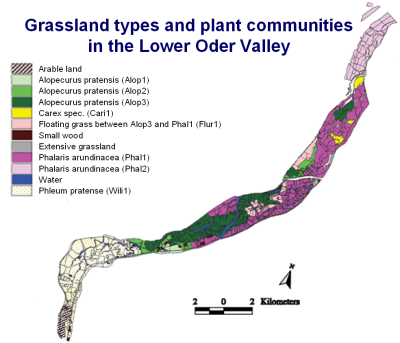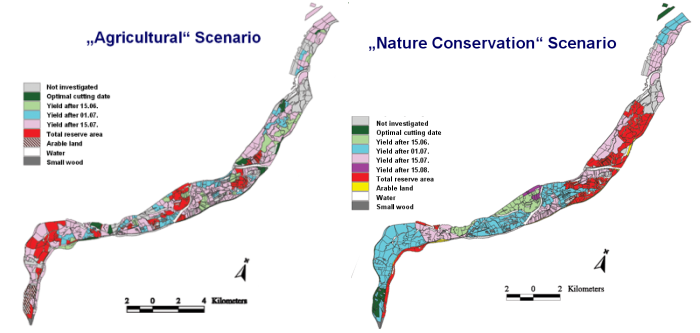Lower Oder Valley
National Park "Lower Oder Valley"
 Harald Kächele (find Harald on the MODAM team page) developed a model version which focused on the consequences of the designation of nature protection areas for single farms within these areas (Kächele 1999). The aim of this project is to contribute to avoid conflicts between agriculture and nature conservation.
Harald Kächele (find Harald on the MODAM team page) developed a model version which focused on the consequences of the designation of nature protection areas for single farms within these areas (Kächele 1999). The aim of this project is to contribute to avoid conflicts between agriculture and nature conservation.
The national park "Lower Oder Valley" comprises about 10.000 ha along the German-Polish border south of the city Schwedt. Core element of the park are some 6.200 ha grassland polder that were gained by dyking the Oder river in the early 20th century. Before 1990 this area was intensively farmed and is so although to a lesser degree up to today. About 50 percent of the park area has to be total reserve from 2010 on. Due to the designation of the national park thus more than 1.000 ha grassland will have to be permanent set-aside. The project includes 32 farms which together hold more than 90 percent of the grassland polder. The yield was estimated with reference to intensive, twenty year long research on the polder grassland (Schalitz 1995). The model captures all fields in the research area with their individual yields, inputs and transportation costs in relation to the farm-field distance. Different types of usage (silage or hay) as well as different cutting dates were in combination with four different frequencies of usage included in the model.
A number of model runs were calculated for different landuse scenarios to optimise the designation for the total reserve area. As reference scenario a hypothetic situation without national park was assumed. Additionally two extreme scenarios were defined: one with a focus solely on agriculture one with a focus on nature conservation. As minimum restriction for both scenarios the 1.146 ha grassland polder that had to become total reserve area was given.
In the agriculture scenario the farmers themselves decide based on their utilisation costs which plots they want to give up for the reserve. In the nature conservation scenario the area for the total reserve is decided upon by the national park administration.
The nature conservation scenario causes a decrease in contribution margin of 650.000 Euros whereas the agriculture scenario only causes a decrease of 165.000 Euros. In the agriculture scenario however the total reserve areas are small and scattered and lie in ecologically less favourable zones. Both scenarios lead to results that are highly unattractive for the opposite side. The nature protection scenario exceeds by far the limit of available means for compensation payments, the agriculture scenario is unacceptable from the ecological point of view (Kächele & Zander 1999).
Based on these extreme positions Kächele calculated compromise scenarios that sadly did not find their way into the real world because a full scale conflict had already erupted between farmers and nature conservationists. The dynamic of events in the "Lower Odervalley" region shows that MODAM can deliver theoretically sound compromises to practical problems. The implementation however can only be successful if the model is referred to as early in the process as possible and if the model is flexible and readily available.
Literature
Kächele, H. 1999. Auswirkungen großflächiger Naturschutzprojekte auf die Landwirtschaft. Ökonomische Bewertung der einzelbetrieblichen Konsequenzen am Beispiel des Nationalparks "Unteres Odertal". Agrarwirtschaft. (Sonderheft 163): 222p.
Kächele, H. und P. Zander. 1999. Der Einsatz des Entscheidungshilfesystems MODAM zur Reduzierung von Konflikten zwischen Naturschutz und Landwirtschaft am Beispiel des Naturparks "Unteres Odertal". In: E. Berg, W. Hinrichsmeyer and G. Schiefer [Eds.]. Agrarwirtschaft in der Informationsgesellschaft. Münster-Hiltrup: Landwirtschaftsverlag. (Schriften der Gesellschaft für Wirtschafts- und Sozialwissenschaften des Landbaus, Bd. 35) p. 191-198
Schalitz, G. 1995. Ausgangsdatenbasis 1992 Grünland. In: H.-R. Bork, C. Dalchow, H. Kächele, H.-P. Pior and K.O. Wenkel [Eds.] Agrarlandschaftswandel in Nordost-Deutschland unter veränderten Rahmenbedingungen: ökologische und ökonomische Konsequenzen. Berlin: Ernst und Sohn. p. 63-67.

